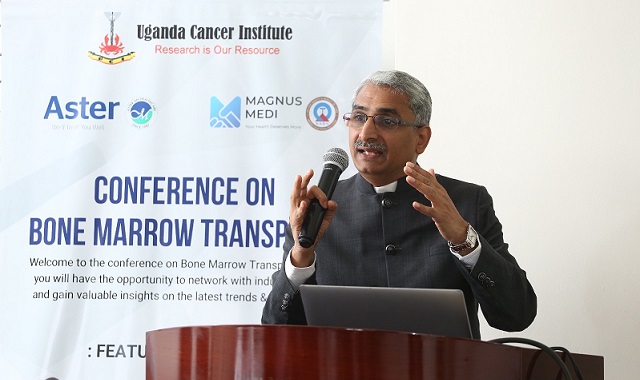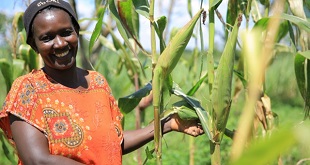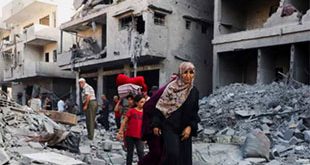
Experts discuss essential factors and challenges
Kampala, Uganda | PATRICIA AKANKWATSA | Uganda Cancer Institute in collaboration with Magnus Medi and Aster Healthcare has been in talks about setting up a Bone Marrow Transplant (BMT) facility at the institute to reduce the number of Ugandans who travel abroad for the procedure.
In the latest engagement, they held a conference on July 20 that discussed the essential factors and challenges they may face in the process.
While speaking at the conference, Dr NV Ramaswamy the director Haematologist, at Aster, Medicity India said that one of the factors that should be considered is establishing and maintaining bone marrow donor registries. He said that it is pivotal for finding compatible donors for transplant recipients.
He said that donor registries play a crucial role in the success of bone marrow transplants by connecting patients in need with potential compatible donors.
“Collaborations with national and international donor registries enhance the chances of locating suitable donors for patients within Uganda and across borders,” he said, “These registries serve as centralized databases that collect and store information from individuals who have volunteered to be bone marrow donors.”
He added that this can be done by increasing the donor pool, encouraging individuals to register as bone marrow donors as well as collaborating with national and international donor registries, especially for patients who do not find compatible donors within their own country.
“Cross-border collaborations expand the pool of potential donors, providing a broader scope for locating suitable matches,”
The bone marrow is a spongy soft tissue located in the bones that helps in the formation of red and white blood cells. It also helps in the formation of blood platelets that help with blood clotting.
Bone marrow or stem cell transplants are a medical procedure where healthy blood-forming stem cells are infused into the body to replace damaged or diseased bone marrow.
Bone marrow transplants treat persons with leukaemia, lymphoma, and some autoimmune diseases in Uganda. The goals differ depending on the circumstances of each case, but they frequently include treating or controlling the condition, extending life, and increasing the quality of life.
According to the Uganda Medical Board, more than 20 Ugandans annually travel abroad to countries such as India to seek bone marrow transplants. Most of the patients who need the treatments have either leukaemia or sickle cell anaemia.
Dr Henry Ddungu a Consultant, Hematology/Oncology at the Uganda Cancer Institute said that the cornerstone of any successful bone marrow transplant facility lies in the expertise and dedication of a specialised medical team. Haematologists, oncologists, transplant nurses, and supporting staff with comprehensive knowledge and experience in bone marrow transplantation are essential to ensure safe and effective patient care.
“This is why we have assembled and dedicated a team to make sure we are in the same understanding of the Bone Marrow Transplant. We have had continuous training and education for healthcare professionals involved in bone marrow transplantation to ensure adherence to best practices and the latest advancements in the field,” he said.
He added that a state-of-the-art infrastructure is a fundamental component for the successful operation of a bone marrow transplant facility.
“The intricate and high-risk nature of bone marrow transplantations demands an environment equipped with cutting-edge technologies, advanced facilities, and stringent infection control measures. We need a facility that is on international standards,” he said.
Dr Ddungu also said that they need collaborations with other countries to provide expertise in setting up a Bone Marrow Facility.
“We are not able to do everything on our own. Bone Marrow Transplants have many types of transplants and there are some we can’t handle on our own. This is why we need collaborations. We don’t want to be a facility that exports patients,” he said.
Dr Nixon Niyonzima, the head of the research and training directorate at the Uganda Cancer Institute says they want to start with carrying out autologous transplants (self-donating).
In an autologous bone marrow transplant, the patient serves as the donor. Before undergoing high-dose chemotherapy or radiation therapy, a sample of the patient’s bone marrow or peripheral blood stem cells is collected and stored. After the intensive treatment, the stored stem cells are infused back into the patient’s bloodstream to help restore the damaged bone marrow and immune system.
At the conference, some challenges that may be faced were discussed and the most resounding one was the significant financial investment required to establish a bone marrow transplant facility. The successful implementation of such a specialised medical facility demands a significant financial investment, encompassing various aspects, including acquiring state-of-the-art equipment, upgrading existing infrastructure, and sustaining ongoing operations.
According to Dr Niyonzima, the government allocated Shs5 billion to facilitate training of staff procurement of equipment needed to start the facility. At the moment, Ugandans seeking transplants abroad need between Shs150 million to Shs200 million for the procedure and accommodation for at least one month in India during recovery.
Dr Niyonzima said at UCI, the transplants will be cheaper than what Ugandans currently spend to travel abroad. In addition to carrying out transplants, he says the transplant centre will also provide aftercare services for Ugandans who have travelled abroad for transplants and need to be looked after by the trained staff.
 The Independent Uganda: You get the Truth we Pay the Price
The Independent Uganda: You get the Truth we Pay the Price



